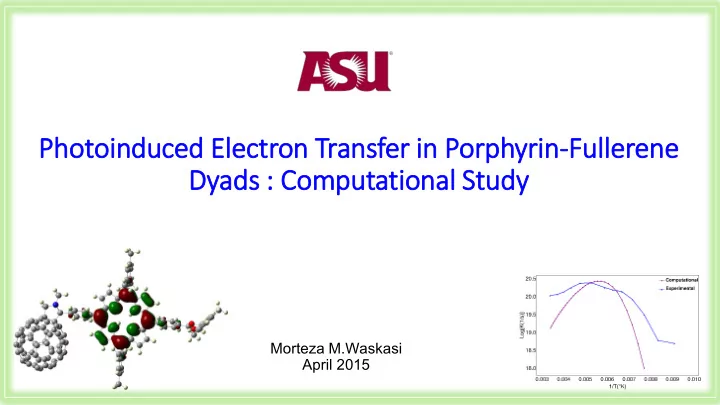

Photoinduced Ele lectron Transfer in in Porp rphyrin-Fullerene Dyads : : Computational Study Morteza M.Waskasi April 2015
Outline Porphyrin-Fullerene Dyad Aim of research – challenge in Porphyrin-Fullerene Dyad The energy level of charge separated state as function of polarity of solvents. Marcus approach to calculate the ET rate Charge recombination Rate in 2-MeTHF and PhCN and comparison with experimental results Summary and future work. 2
Porphyrin-Fullerene Dyad Porphyrin Similar to natural chlorophyllide chromophores. Extensive conjugated 𝞺 -system. Favourable oxidation potential. Large extinction coefficients in visible region. Fullerene Good combination with porphyrins as a strong electron acceptor. Remarkable electron acceptors due to their large symmetrical shape and delocalized 𝞺 -system. Fullerenes are light absorber in the visible region. Small reorganization energy. 3 H. Imahori, K. Hagiwara .Journal of the American Chemical Society 118 , 11771 – 11782 (1996).
Challenges in in ET in in Porp rphyrin-Fullerene Dyad Create long-lived charge separated state Retarding charge recombination Charge recombination and charge separation occur in inverted or normal regime ? Char arge recombin ination is is in in in inverted regime BELIEVED Charge separation is in the normal regime Prove or or dis isprove AIM 4
Methods Gaussian 09: Optimization Charge Internal reorganization energy Qchem: Optimization of Charge Separated State Charge Calculation at Separated State Electronic Coupling Solv lvMol: : Solvent reorganization Energy Solvent Free Energy Correction to the experimental free energy 5 D.Matyushov, Chemical Physics , 324 , 172-194(2006).
Donor and A Acceptor 6
The ET rate constant calc lculation: : Semiclassical Marcus equation ∆ 𝙷 = ∆ 𝙷 𝘩𝘣𝘵 + + ∆ 𝙷 𝘵 λ ~0.5 .56 eV ∆ 𝙷 𝘩𝘣𝘵 ~1.0 .01 eV V ~0.0 .0002 eV 7 A. Nitzan, Chemical Dynamics in Condensed Phases (Oxford University Press, 2006) p. 744.
Energy Level dia iagram in in gas and polar solv lvents C 60 Ph 1.91 eV - ∆G λ hν Gas 1.01 0.14 Ph C 60 THF 0.78 0.56 MTHF 0.78 0.56 ∆G PhCN 0. 34 1.39 C 60 Ph 0 DMF Kodis, G.; Liddell, P. A.; Moore, A. L.; Moore, T. A.; 0.26 1.53 8 Gust, D. J. Phys. Org. Chem., 2004, 17, 724-734.
The ET rate constant calc lculation: : Marcus equation λᵥ ~0.146 eV Energy 9 R.C P.Barbara, T.Meyer, M. Ratner. J. Phys. Chem. 100 , 13148-13168(1996)
Solvent Reorganization and Free Energy in in MTHF μ= 1.38 D α = 10 (Å)³ ε = 7.6 10
Energy Gap in in MTHF 11
Dri riving Force and Reorganization Energy λ - ∆G 12
Recombination Rate in in 2-MeTHF Coplanar Energy Gap=0 Bent Energy Gap=0 Inverted Normal Normal Inverted regime regime regime regime - ∆G 13 Experimental result by Gerdenis Kodis ,EFRC.
CS and CR in in PhCN PhCN solv lvent: : In Inverted or r Normal regime? C 60 P 1.91 eV - ∆G λ hν 1.01 0.14 Gas P C 60 1.58 ---- Exp 0. 34 1.39 PhCN ∆G C 60 P 0 Kodis, G.; Liddell, P. A.; Moore, A. L.; Moore, T. A.; 14 Gust, D. J. Phys. Org. Chem., 2004, 17, 724-734.
CS and CR in in PhCN PhCN solv lvent: : In Inverted or r Normal regime? C 60 P P C 60 1.91 eV ∆G cs P C 60 1.01 Gas P C 60 P C 60 1.58 Exp ∆G g 0. 34 Emp ∆G P C 60 C 60 P 0 15
Summary ry Temperature dependence of charge recombination rate. Inverted Normal regime regime Same trend of K ET for both experimental and computational approaches. Solvent reorganization energy increase and driving force decrease by increasing polarity of the solvents. The lifetime of charge separated states vary as a function of polarity of solvents and temperature. Solvent reorganization energy and driving force rush in opposite way by increasing T in 2-MeTHF. Good agreement between calculated and the experimental rate is found for P-C 60 in 2-MeTHF solvent. 17
Future work Finding other conformers of porphyrin-fullerene Dyad. Investigation of charge separation rate vs. temperature. Make a model for forward and back ET for porphyrin fullerene dyad and then extend it for other artificial reaction centers to predict the electron transfer rate as function of temperature and polarity of solvent. 18 T. Karilainen, O. Cramariuc , J of Computational Chemistry 36 , 612 – 621 (2015)
Recommend
More recommend